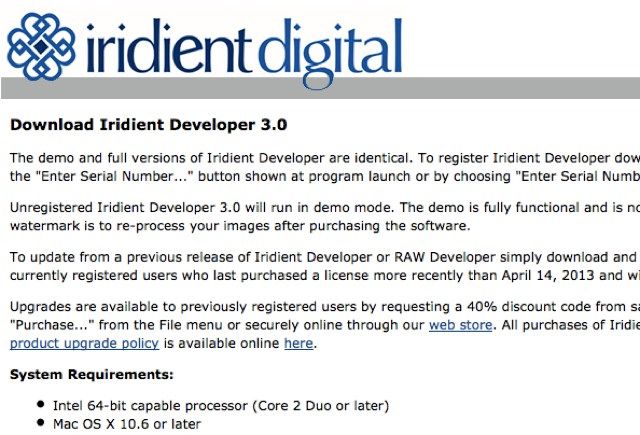AVAILABLE: The final release of Iridient Developer 3.0!
The final release of Iridient Developer 3.0 is available for download now here.
This major update contains many new features and significant improvements throughout the application. Some of the key new features introduced in version 3 inlude:
– Multiple new RAW processing (demosaic) algorithms for both Bayer and X-Trans sensors from super high detail to smoother, lower artifact rendering styles plus monochrome specific RAW conversions.
– Two great new sharpening methods, Iridient Reveal and High Pass, have been added to the already highly regarded sharpening routines. Iridient Reveal in beta form has already been getting rave reviews and combines some of the best aspects of several of my previous methods including aspects of both traditional edge contrast enhancement techniques and deconvolution.
– New options for adjusting overall tonality including an adaptive “Fill Light” style exposure adjustment and pixel neighborhood adaptive Highlights and Shadows adjustments.
– New Clarity adjustment for enhancing mid-tone contrast and reducing haze. This adjustment includes a number of variants for targeting different styles from a crisp, landscape type effect to softer, more portrait suited styles.
– New noise reduction methods provide much better results when combined with some of the new sharpening methods, especially when using very strong sharpening. At high levels some color smearing has been reduced while providing comparable or even better overall color noise reduction than the previous v2 methods. The new Luminance Grain Smoothness adjustment provides much better retention of overall image sharpness than the previous Luminance Smoothing method while being even more effective at reducing critical noise. Depending on specific adjustments used and image content, the new noise reduction can also be up to twice as fast as the previous v2 methods.
– Several all new monochrome mixer conversion methods which can radically reduce noise and provide even better image detail especially when using strong red biased filter type presets. Several options including direct access to low level RAW linear data as well as more perceptual, color managed mixing styles.
– Two new monochrome toning methods including Split Toning and Mono Tone plus many presets for common toning styles such as Sepia, Cyanotype, Platinum and more.
– New support for saving presets (or settings subsets) to disk which makes applying only specific adjustments, such as only sharpening, to images much easier. Also adds the ability to organize the Settings popup menu by sub-folders for grouping commonly used presets together.
– New dialog for copying/pasting settings subsets which makes choosing multiple adjustment options much easier than before when there was only a limited set of subsets available for selection by menu item.
– Greatly improved preview window approximation of various “Detail” processing stages (clarity, sharpening, noise reduction) when displaying at small scale sizes.
– Significant improvements have been made to many existing processing methods and controls as well including Brightness, Saturation, Contrast and Tone Curves.
– Greatly simplified color management setup and configuration. Still features all the low level color management control of prior versions (and more), but now much easier to configure for the most common use cases.


